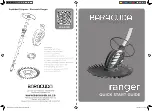
12
• Linerlock is the white plastic extrusion that the pool
liner hangs from.
• Although the linerlock can be cut straight at a 90
degree angle a neater finish and better fixed liner
will be achieved by cutting at 22½ degrees. A mitre
block will help with this.
• Take a length of linerlock and trim one end to
approximatley 22½ degrees.
[See Figure C01]
• Clamp or hold this length of linerlock along the
inside of one pool wall and mark the length. The
correct length is to have the linerlock for each wall
meeting in the corner with only a minimal gap (1 or
2 mm) as shown in
figure C02
. Cut the other end
to 22½ degrees.
• Lay the trimmed linerlock along the top of the pool
wall and use a 3mm drill bit to make pilot holes
starting 25mm in from each end and at
approximately 200mm - 250mm centres.
• Use the 3.5mm x 40mm screws from your fixings
kit to fix the linerlock to the inside of the wall.
[See
Figure C02]
• The linerlock must be flush with the top of the wall.
• Repeat this procedure for each wall ensuring that
where the linerlock meets in the corners it is at the
same level.
• It may be necessary to make some sections from
two pieces as the Iinerlock is supplied in standard
lengths, which do not divide exactly into the
correct sizes for all pools.
• Ensure that no linerlock screws are left protruding
and have no sharp edges that could damage the
liner.
SECTION C: Fitting the Liner
Fitting the Linerlock
• If you have assembled your pool on a subsoil base
rather than a concrete pad, it is likely that the area
inside the pool will have become disturbed while
you worked. If you used a concrete base this
section is not required.
• Although the floor felt and liner could be fitted on
uneven subsoil it is not recommended and a better
finish with longer liner life will be achieved by
levelling the floor as follows.
• Draw a pencil line all around the inside on the pool
wall 20mm up from the bottom.
• Remove any loose dirt from inside the pool.
• Use a dry mix of 4 parts sharp sand to 1 part
cement and spread evenly over the floor.
• Use a straight edge and plastering float to achieve
a flat, level finish.
• Do not let the sand and cement level go any higher
than 20mm above the base of your pool where you
made your pencil line.
• Moisture in the air and soil base will cure the sand
and cement mix.
• Let the floor harden before proceeding.
Levelling the Floor
Figure C01
Figure C02







































